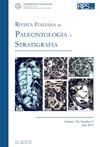PALAEONTOLOGY OF THE UPPER PLIOCENE MARINE DEPOSITS OF RIO VACCARUZZA, VILLALVERNIA (PIEDMONT, NW ITALY)
IF 1.9
3区 地球科学
Q2 GEOLOGY
引用次数: 2
Abstract
Abstract. The topmost Argille Azzurre (beds 1-2) and the basal Sabbie di Asti (beds 3-9) formations in the Villalvernia area are analysed in terms of palaeoecological and taxonomic features; the succession is 6 m thick and dates back to the middle Piacenzian within the Globorotalia bononiensis acme. The upper boundary of the clayey Bed 2 corresponds to an unconformity reflecting Pliocene tectonic activity. The study is focused on the fossil assemblages of beds 3, 4 and 9. The sandy Bed 3 yields 362 mollusc taxa; their assemblage is allochthonous and mixes infra- to circalittoral species accumulated by hyperpycnal mass-transport. The same mechanism is responsible for the origin of the overlying fossil unit (Bed 4) with numerous specimens of the Entobia-Gastrochaenolites ichnofacies. The autochthonous fossil assemblage of Bed 9 yields 308 molluscs, plus three brachiopods and ten fish taxa; most of them refer to the Posidonia meadow (HP), and their autochthony is shown by taphonomic features as skeletal integrity, mixing of successive generations or the limitation to juvenile ontogenetic stages of vagile and temporarily byssate species for which the HP performs a nursery function. Three brachiopods and 52 molluscs are here reported for the first time from the Pliocene of Piedmont. In the final chapter “Systematic Palaeontology” four brachiopods and 29 molluscs are described, among which there are eight new gastropod species: Crepidula bellardii n. sp., Conus dellabellai n. sp., Conus villalvernensis n. sp., Odetta chirlii n. sp., Ondina curta n. sp., Ondina elongata n. sp., Ondina pseudovitrea n. sp., Anisocycla subcylindrica n. sp.意大利villalvernia地区里约热内卢vaccaruzza上新世海相沉积古生物学
摘要对Villalvernia地区最顶端的Argille Azzurre组(1-2层)和底部的Sabbie di Asti组(3-9层)进行了古生态和分类特征分析;该演替层厚达6米,可追溯至中皮亚琴世,位于Globorotalia bononiensis顶点内。粘土2层的上边界对应一个反映上新世构造活动的不整合面。研究重点是3层、4层和9层的化石组合。砂质层3有362个软体动物类群;它们的组合是异域的,混合了由超旋向质量搬运积累的下旋向物种。同样的机制也解释了上覆化石单元(第4层)的起源,该化石单元具有大量的恩托比亚-胃脉绿岩相标本。9层的本地化石组合有308种软体动物,3种腕足动物和10种鱼类;它们大多指Posidonia草甸(HP),它们的本土性表现为骨骼的完整性、连续世代的混合或局限于幼年个体发育阶段的游动和暂时的准稳态物种,HP对这些物种起着托儿所的作用。本文首次报道了皮埃蒙特地区上新世腕足动物3种,软体动物52种。最后一章“系统古生物学”介绍了4种腕足动物和29种软体动物,其中新发现腹足类8种:贝拉氏Crepidula bellardii n. sp.、扁锥蚌(Conus dellabellai n. sp.)、小圆锥蚌(Conus villalvernensis n. sp.)、小圆锥蚌(Odetta chirlii n. sp.)、圆锥蚌(Ondina curta n. sp.)、长形锥蚌(Ondina elongata n. sp.)、假玻璃锥蚌(Ondina pseudovitrea n. sp.)、圆柱下异环蚌(Anisocycla sub圆柱)。
本文章由计算机程序翻译,如有差异,请以英文原文为准。
求助全文
约1分钟内获得全文
求助全文
来源期刊
CiteScore
3.60
自引率
4.30%
发文量
28
审稿时长
>12 weeks
期刊介绍:
The Rivista Italiana di Paleontologia e Stratigrafia was founded in 1895. It publishes original papers dealing with all fields of paleontology and of stratigraphy, from Italy and the Mediterranean to the Tethys, as well across the globe from China to North America.

 求助内容:
求助内容: 应助结果提醒方式:
应助结果提醒方式:


